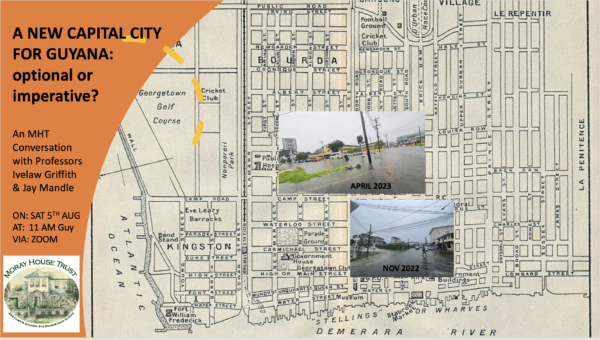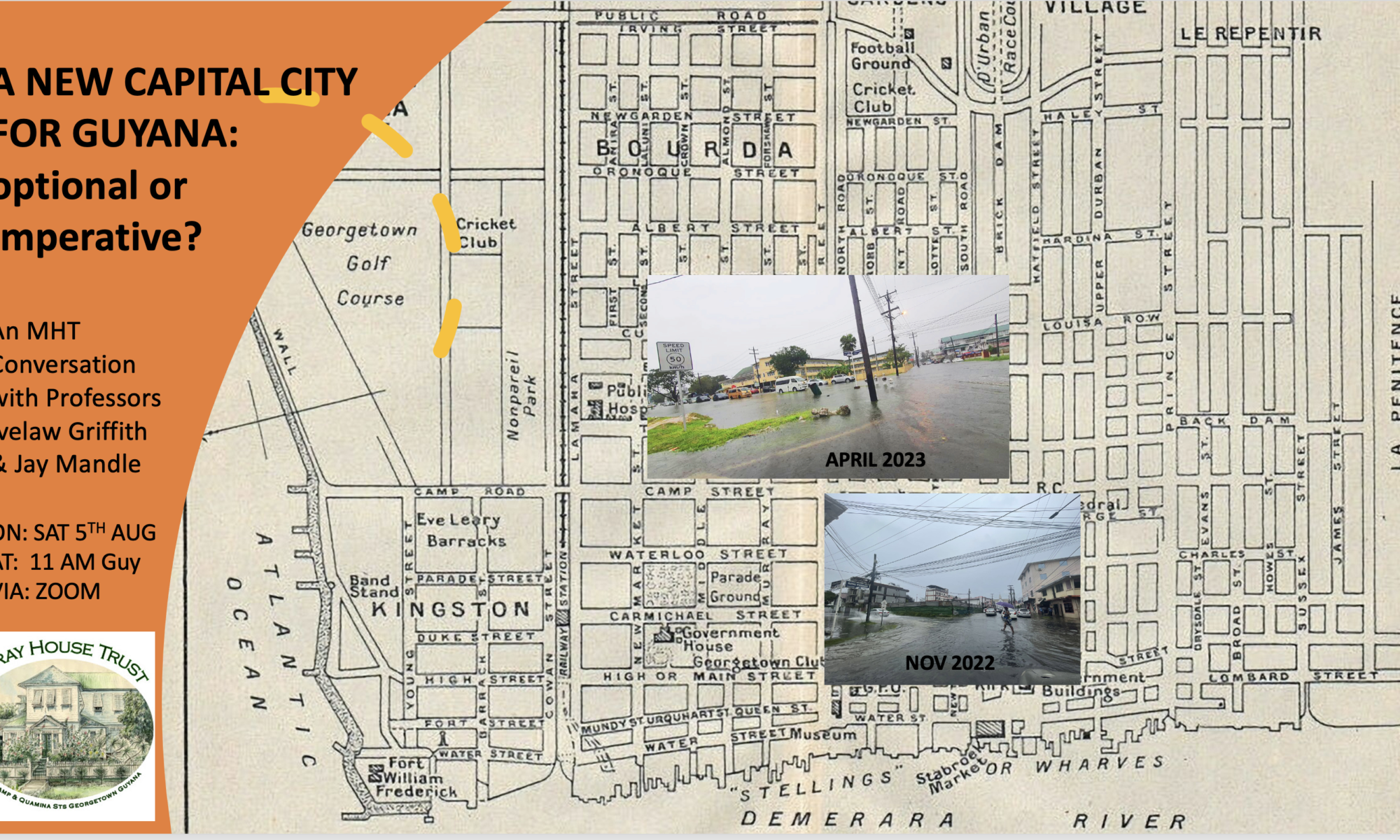Activity: Moray House Trust Conversation
Topics: Climate Change, Petroleum, Urban Policy and Planning
Host: Moray House Trust
Date: Saturday 5th August 2023
Time: 11.00 AM Guyana, NY / 4.00 PM UK
YouTube: https://youtu.be/XRL4lBGridM

Moray House Trust hosted another MHT Conversation:
Here is a short introductory video: https://youtu.be/_aFZdwOpmek
Event: MHT Conversation
Title: A New Capital City for Guyana: optional or imperative?
Speakers: Professor Jay Mandle, Professor Ivelaw L. Griffith
Moderator: Isabelle de Caires
Date: Saturday 5th August
Time: 11.00 AM (Guyana, NY), 4.00 PM UK
Generations of Guyanese have clung to the coastland. Our capital city sits on the shores of the Atlantic. As climate change unfurls in the Caribbean region, that location looks less than auspicious.
Professor Jay Mandle has written two papers (2016,2019) directly addressing this topic. Professor Griffith recently published a paper as well. We invite you to join us to hear their thoughts and to pose your own questions and comments.
MODERATOR’S INTRO:
On behalf of Moray House Trust, welcome to this conversation: A New Capital City for Guyana: optional or imperative?
For those joining us for the first time, Moray House Trust is a private, non-partisan, non- profit based in Georgetown. The Trust operates on the belief that a culture thrives and develops where ideas circulate and are robustly debated and interrogated. It has worked for a decade to promote culture and public discourse in Guyana. My name is Isabelle de Caires. I am the Chair of Trustees at Moray House Trust and the moderator for today’s conversation. A warm Guyanese welcome to our regulars.
The aim of these Conversations is to encourage those who write analytically about Guyana to share some of their research and ideas with our audience. As we have said previously, in these fora, we do not presume to offer definitive answers to complex questions. With luck, we might succeed in formulating some definitive questions. In other words, this is a forum for the exchange of ideas and for critical thinking.
Let us begin with a look at a painting that offers penetrating insights into the Guyanese psyche. In 1951 E.R Burrowes painted Land of the Dolorous Garde. On the left, we see the politicians in suits performing their high wire act, with a large blue cushion to soften any miscalculations. On the right, the half-built shack symbolises the state of the country: the people crawl through its doorway, distracted, looking down. The red-clad figure in the foreground, head buried in the sand, also represents the people. This figure embodies our current approach to climate change and to the challenges it poses to our capital city. We are preoccupied with other things. We can’t focus on that now. However, as the floods increase in frequency and intensity, avoidance of the topic is no longer a viable strategy. As Jay Mandle warns, ‘the sea will not wait.’ We must craft a plan.

As our introductory clip showed, the need to prepare has been raised repeatedly over the past 20 years. In 2002, a report by the EPA entitled Guyana’s Coastal Vulnerability and Risk Assessment warned of large-scale disruption of population centres. In 2011, a cluster of ECLAC studies, assessing the need for coastal adaptation to climate change in Guyana, prioritised the relocation of critical infrastructure and preparations for a ‘planned retreat.’ In 2013, a National Land Use Plan prepared by the Guyana Lands and Surveys Commission identified new locations with high development potential. Professor Jay Mandle first raised the subject of relocation of the capital in the first C.Y Thomas Distinguished Lecture at the Pegasus Hotel in October 2016. Professor Griffith was the Chancellor of the University of Guyana at the time. In 2019 Professor Mandle raised the subject again, in a lecture comparing the challenges climate change poses to Barbados and to Guyana. Writing a Policy Brief in International Journal earlier this year, Professor Griffith was even more blunt stating that ‘the Guyana capital is forecast to be fully or partially submerged by 2030.’
To paraphrase Martin Carter then, today’s conversation is a fragment of a much larger conversation, a conversation stretching across the past, the present and the future and taking place within and beyond our shores. Globally, there is a sense that we are at a pivot point. As a columnist in last weekend’s Financial Times noted: ‘no country will be immune from climate change….Extreme weather has already made some US homes uninsurable. Canada has lost more land to wildfires this year than any other on record. Meanwhile Greece, Italy and Spain, sweltering in 40C heat, must fear for the future of their tourist industries.’ In the near-term in Guyana we face similar risks. Repeated flood damage is already marginalising traditional agricultural land along our coast. And in Georgetown, some of our most sought-after neighbourhoods are within spitting distance of the shoreline. Some have been built on flood plains. What happens if insurance companies refuse to insure entire neighbourhoods and critical infrastructure? Do we have a plan for this?
The future conversation of which this is a fragment might include questions like: What will a new capital city look like? Who will be its architects and planners? Will its design be the result of a consultative process? Some may see Silica City as the solution. There is both a surfeit of hype and a deficit of detail about Silica City in the public domain. In this respect it is like Neom, Mohammed Bin Salman’s pet project in Saudi Arabia. I could find no public reference to Silica City serving as a future capital city. It will cater to about 3000 households in its first five years, rising to 12,500 households or about 50,000 people within 20 years. This is a town not a city and, at best, a partial answer to climate induced displacement from the coast. The mystery shrouding the plans for Silica City and the uncertainty about Georgetown’s future obscure deeper questions: what does a climate-resilient cityscape look like? And, perhaps most profoundly, how do we want to live?
The possible need for a new capital city is itself one fragment of a much larger challenge. Jay Mandle talked in both of his papers about the need for a radical restructuring of Guyana’s economy to cope with climate change. This is a much bigger task than moving a capital city.
So, now that we have an idea of the scope and scale of the topic, a brief note about our two speakers.
Jay Mandle, a Professor of Economics, was based at Colgate University for nearly 30 years, retiring in 2017. He spent an early part of his teaching career at the University of Guyana. He is the author of 15 books and over 100 papers. Ivelaw Lloyd Griffith is a Senior Associate at the Center for Strategic and International Studies, and Co-founder and Fellow of the Caribbean Policy Consortium, both based in Washington DC. He served as Tenth Vice-Chancellor and Principal at the University of Guyana. He has recently been commissioned by Routledge (London) to edit a volume about Oil and Climate Change in the Guyana-Suriname Basin.

